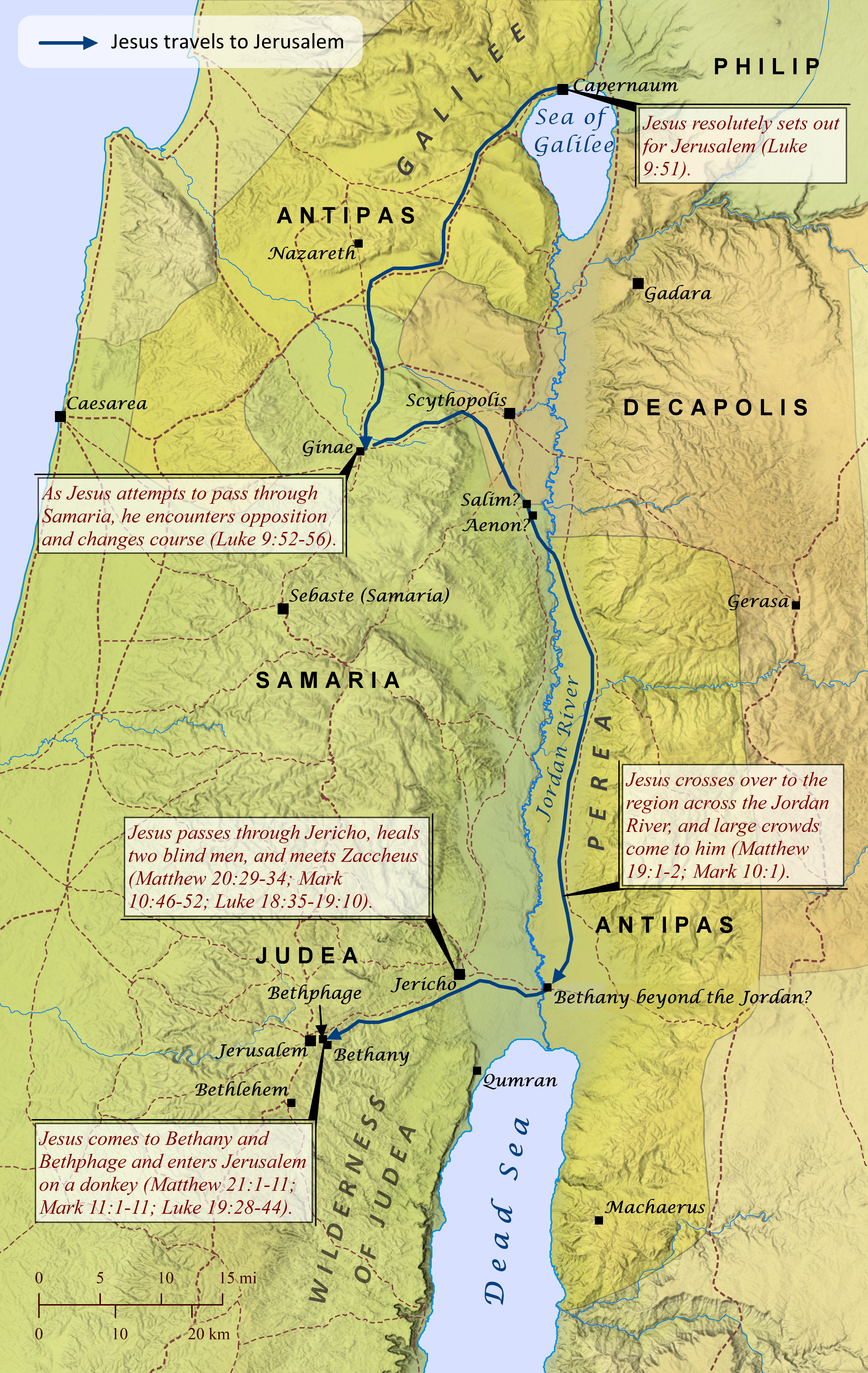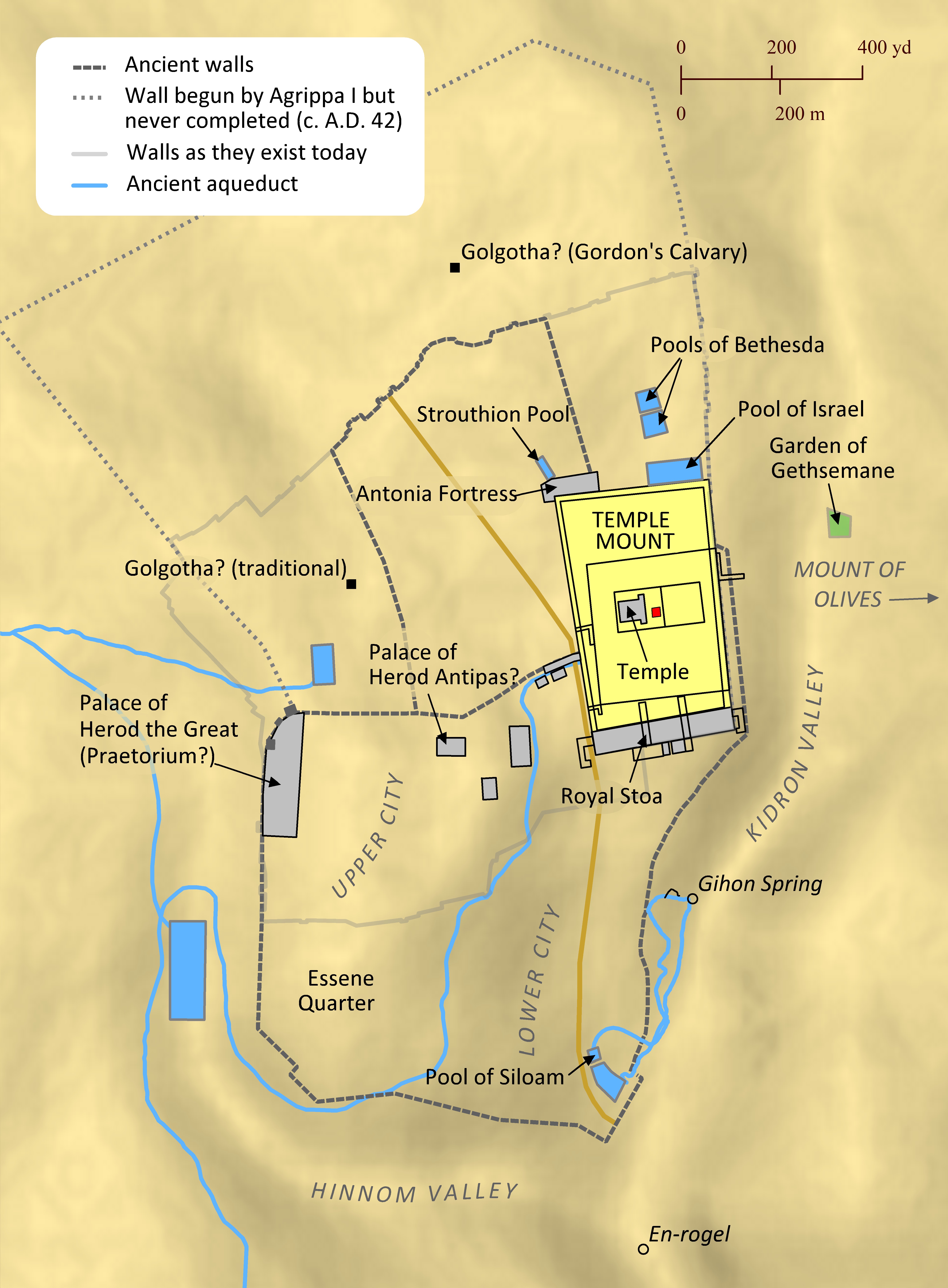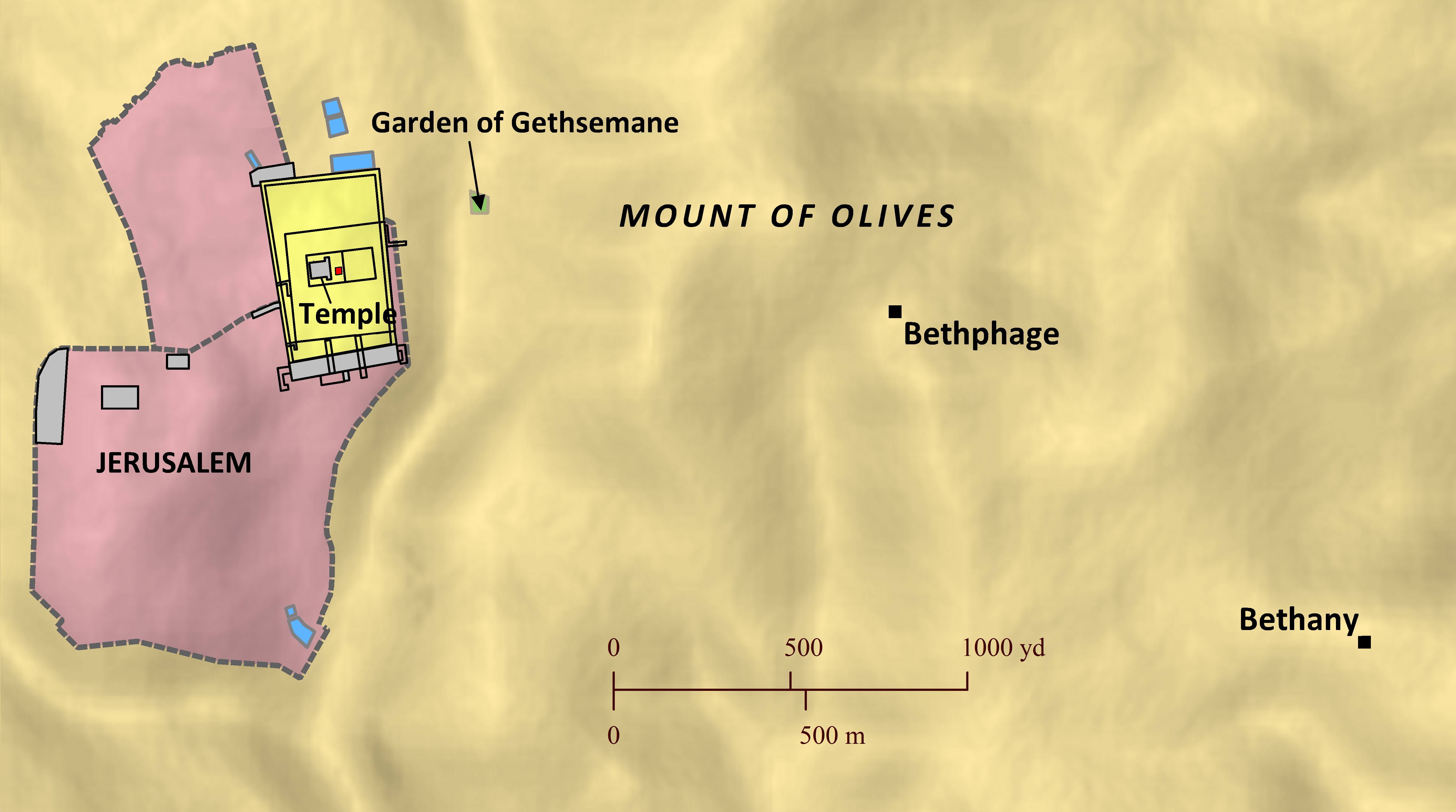Note: This view shows ‘verses’ which are not natural language units and hence sometimes only part of a sentence will be visible—click on any Bible version abbreviation down the left-hand side to see the verse in more of its context. Normally the OET discourages the reading of individual ‘verses’, but this view is only designed as a tool for doing comparisons of different translations—the older translations are further down the page (so you can read up from the bottom to trace the English translation history). The OET segments on this page are still very early looks into the unfinished texts of the Open English Translation of the Bible—please double-check these texts in advance before using in public.
AICNT saying, “Go into the village opposite, in which as you enter you will find a colt [tied, on which no one [of men][fn] has [ever][fn] sat; [and][fn] having untied it, bring it here].[fn]
OEB ‘Go to the village facing us,’ he said, ‘and, when you get there, you will find a foal tethered, which no one has yet ridden; untie it and lead it here.
WEBBE saying, “Go your way into the village on the other side, in which, as you enter, you will find a colt tied, which no man has ever sat upon. Untie it and bring it.
WMBB (Same as above)
NET telling them, “Go to the village ahead of you. When you enter it, you will find a colt tied there that has never been ridden. Untie it and bring it here.
LSV having said, “Go away into the village in front of [you], in which, entering in, you will find a colt bound, on which no one of men ever sat, having loosed it, bring [it];
FBV “Go to the village farther on. As you enter it you'll find a colt tied up that no one has ever ridden. Untie it and bring it here.
TCNT saying, “Go into the village ahead of you. As you enter it, you will find a colt tied, on which no one has ever sat. Untie it and bring it here.
T4T he said to two of his disciples, “Go to the village just ahead of you. As you two enter it, you will see a young animal that no one has ever ridden, that has been {someone has} tied up. Untie it and bring it to me.
LEB saying, ‘Go into the village in front of you, in which as you[fn] enter you will find a colt tied, on which ⌊no person has ever⌋[fn] sat, and untie it and[fn] bring it.[fn]
BBE Saying, Go into the little town in front of you, and on going in you will see a young ass fixed with a cord, on which no man has ever been seated; let him loose and take him.
Moff saying, "Go to the village in front, and on entering it you will find a colt tethered on which no one ever has sat; untether it and bring it.
Wymth saying to them, "Go into the village facing you. On entering it you will find an ass's foal tied up which no one has ever yet ridden: untie it, and bring it here.
ASV saying, Go your way into the village over against you; in which as ye enter ye shall find a colt tied, whereon no man ever yet sat: loose him, and bring him.
DRA Saying: Go into the town which is over against you, at your entering into which you shall find the colt of an ass tied, on which no man ever hath sitten: loose him, and bring him hither.
YLT having said, Go away to the village over-against, in which, entering into, ye shall find a colt bound, on which no one of men did ever sit, having loosed it, bring [it];
Drby saying, Go into the village over against [you], in which ye will find, on entering it, a colt tied up, on which no [child] of man ever sat at any time: loose it and lead it [here].
RV saying, Go your way into the village over against you; in the which as ye enter ye shall find a colt tied, whereon no man ever yet sat: loose him, and bring him.
(saying, Go your way into the village over against you; in the which as ye/you_all enter ye/you_all shall find a colt tied, whereon no man ever yet sat: loose him, and bring him. )
SLT Having said, Retire ye to the opposite town; in which entering, ye shall find a colt bound, upon which none of men at any time have sat: having loosed, bring him.
Wbstr Saying, Go ye into the village over against you ; in which at your entering ye will find a colt tied, on which yet never man sat: loose him, and bring him hither .
KJB-1769 Saying, Go ye into the village over against you; in the which at your entering ye shall find a colt tied, whereon yet never man sat: loose him, and bring him hither.
(Saying, Go ye/you_all into the village over against you; in the which at your entering ye/you_all shall find a colt tied, whereon yet never man sat: loose him, and bring him hither/here. )
KJB-1611 Saying, Goe ye into the village ouer against you, in the which at your entring ye shall find a Colt tied, whereon yet neuer man sate: loose him, and bring him hither.
(Saying, Go ye/you_all into the village over against you, in the which at your entering ye/you_all shall find a Colt tied, whereon yet never man sate: loose him, and bring him hither/here.)
Bshps Saying: Go ye into the towne which is ouer agaynst you, into the whiche, assoone as ye are come, ye shall fynde a coult tyed, wheron yet neuer man sate: loose hym, and bryng hym hyther.
(Saying: Go ye/you_all into the town which is over against you, into the whiche, as soon as ye/you_all are come, ye/you_all shall find a coult tied, wheron yet never man sate: loose him, and bring him hither/here.)
Gnva Saying, Goe ye to the towne which is before you, wherein, assoone as ye are come, ye shall finde a colte tied, whereon neuer man sate: loose him, and bring him hither.
(Saying, Go ye/you_all to the town which is before you, wherein, as soon as ye/you_all are come, ye/you_all shall find a colte tied, whereon never man sate: loose him, and bring him hither/here. )
Cvdl and sayde: Go in to the towne that lyeth ouer agaynst you, and assone as ye are come in, ye shal fynde a foale tyed, wheron yet neuer man satt, lowse it, and brynge it hither.
(and said: Go in to the town that lieth/lies over against you, and as soon as ye/you_all are come in, ye/you_all shall find a foal tied, wheron yet never man satt, lowse it, and bring it hither/here.)
TNT sayinge: Goo ye in to the toune which is over agaynste you. In the which assone as ye are come ye shall finde a colte tyed wheron yet never man sate. Lowse him and bringe him hider.
(saying: Go ye/you_all in to the town which is over against you. In the which as soon as ye/you_all are come ye/you_all shall find a colte tied wheron yet never man sate. Lowse him and bring him hider. )
Wycl Go ye in to the castel, that is ayens you; in to which as ye entren, ye schulen fynde a colt of an asse tied, on which neuer man sat; vntye ye hym, and brynge ye to me.
(Go ye/you_all in to the castel, that is against you; in to which as ye/you_all entering, ye/you_all should find a colt of an ass tied, on which never man sat; untye ye/you_all him, and bring ye/you_all to me.)
Luth und sprach: Gehet hin in den Markt, der gegenüberliegt; und wenn ihr hineinkommet, werdet ihr ein Füllen angebunden finden, auf welchem noch nie kein Mensch gesessen ist. Löset es ab und bringet es.
(and spoke: Go there in the Markt, the/of_the gegenüberlies(v); and when you(pl)/their/her into/insidekommet, become you(pl)/their/her a abundancen angebunden find, on/in/to which_one still never no/not person sat is. Löset it ab and brings/gets it.)
ClVg dicens: Ite in castellum quod contra est: in quod introëuntes, invenietis pullum asinæ alligatum, cui nemo umquam hominum sedit: solvite illum, et adducite.[fn]
(saying: Ite in/into/on purelyllum that on_the_contrary it_is: in/into/on that introëuntes, will_findis pullum asinæ alligatum, to_whom nobody/no_one umquam of_men sat_down: solvite him, and adducite. )
UGNT λέγων, ὑπάγετε εἰς τὴν κατέναντι κώμην, ἐν ᾗ εἰσπορευόμενοι εὑρήσετε πῶλον δεδεμένον, ἐφ’ ὃν οὐδεὶς πώποτε ἀνθρώπων ἐκάθισεν; λύσαντες αὐτὸν, ἀγάγετε.
(legōn, hupagete eis taʸn katenanti kōmaʸn, en haʸ eisporeuomenoi heuraʸsete pōlon dedemenon, ef’ hon oudeis pōpote anthrōpōn ekathisen; lusantes auton, agagete.)
SBL-GNT ⸀λέγων· Ὑπάγετε εἰς τὴν κατέναντι κώμην, ἐν ᾗ εἰσπορευόμενοι εὑρήσετε πῶλον δεδεμένον, ἐφʼ ὃν οὐδεὶς πώποτε ἀνθρώπων ἐκάθισεν, ⸀καὶ λύσαντες αὐτὸν ἀγάγετε.
(⸀legōn; Hupagete eis taʸn katenanti kōmaʸn, en haʸ eisporeuomenoi heuraʸsete pōlon dedemenon, efʼ hon oudeis pōpote anthrōpōn ekathisen, ⸀kai lusantes auton agagete.)
RP-GNT εἰπών, Ὑπάγετε εἰς τὴν κατέναντι κώμην· ἐν ᾗ εἰσπορευόμενοι εὑρήσετε πῶλον δεδεμένον, ἐφ' ὃν οὐδεὶς πώποτε ἀνθρώπων ἐκάθισεν· λύσαντες αὐτὸν ἀγάγετε.
(eipōn, Hupagete eis taʸn katenanti kōmaʸn; en haʸ eisporeuomenoi heuraʸsete pōlon dedemenon, ef' hon oudeis pōpote anthrōpōn ekathisen; lusantes auton agagete.)
TC-GNT [fn]εἰπών, Ὑπάγετε εἰς τὴν κατέναντι κώμην· ἐν ᾗ εἰσπορευόμενοι εὑρήσετε πῶλον δεδεμένον, ἐφ᾽ ὃν οὐδεὶς πώποτε ἀνθρώπων [fn]ἐκάθισε· λύσαντες αὐτὸν ἀγάγετε.
(eipōn, Hupagete eis taʸn katenanti kōmaʸn; en haʸ eisporeuomenoi heuraʸsete pōlon dedemenon, ef hon oudeis pōpote anthrōpōn ekathise; lusantes auton agagete. )
Key for above GNTs: yellow:punctuation differs, red:words differ (from our SR-GNT base).
BMM BibleMapper.com Maps:

Jesus’ Final Journey to Jerusalem
Much like the difficulties of discerning the Israelites’ journey to the Promised Land (see here), the task of reconciling the four Gospel accounts of Jesus’ final journey to Jerusalem into one coherent itinerary has proven very challenging for Bible scholars. As with many other events during Jesus’ ministry, the accounts of Matthew, Mark, and Luke (often referred to as the Synoptic Gospels) present a noticeably similar account of Jesus’ final travels, while John’s Gospel presents an itinerary that is markedly different from the others. In general, the Synoptic Gospels present Jesus as making a single journey to Jerusalem, beginning in Capernaum (Luke 9:51), passing through Perea (Matthew 19:1-2; Mark 10:1) and Jericho (Matthew 20:29-34; Mark 10:46-52; Luke 18:35-19:10), and ending at Bethany and Bethphage, where he enters Jerusalem riding on a donkey (Matthew 21:1-11; Mark 11:1-11; Luke 19:28-44). John, on the other hand, mentions several trips to Jerusalem by Jesus (John 2:13-17; 5:1-15; 7:1-13; 10:22-23), followed by a trip to Perea across the Jordan River (John 10:40-42), a return to Bethany where he raises Lazarus from the dead (John 11), a withdrawal to the village of Ephraim for a few months (John 11:54), and a return trip to Bethany, where he then enters Jerusalem riding on a donkey (John 12:1-19). The differences between the Synoptics’ and John’s accounts are noteworthy, but they are not irreconcilable. The Synoptics, after noting that Jesus began his trip at Capernaum, likely condensed their accounts (as occurs elsewhere in the Gospels) to omit Jesus’ initial arrival in Jerusalem and appearance at the Festival of Dedication, thus picking up with Jesus in Perea (stage 2 of John’s itinerary). Then all the Gospels recount Jesus’ trip (back) to Bethany and Jerusalem, passing through Jericho along the way. Likewise, the Synoptics must have simply omitted the few months Jesus spent in Ephraim to escape the Jewish leaders (stage 4 of John’s itinerary) and rejoined John’s account where Jesus is preparing to enter Jerusalem on a donkey.

Jerusalem during the New Testament
By the time of the New Testament, the ancient city of Jerusalem had been transformed from the relatively small fortress of David’s day (2 Samuel 5:6-10; 1 Chronicles 11:4-9) into a major city with a Temple that rivaled the greatest temples in the Roman world. Just prior to Jesus’ birth, Herod the Great completely renovated and expanded the Temple of the Lord, and he also built a lavish palace for himself, various pools (where Jesus occasionally performed healings), public buildings, and military citadels, including the Antonia Fortress, which overlooked the Temple. Wealthy residents, including the high priest, occupied extravagant houses in the Upper City, while the poorer residents were relegated to less desirable areas like the Lower City. The Essene Quarter was so named because many of its residents belonged to the Essenes, a strict religious sect that was known for its careful attention to the law of Moses. Across the Kidron Valley lay the Garden of Gethsemane, where Jesus often met with his disciples (Matthew 26:36-46; Mark 14:32-53; John 18:1-14). Further east was the Mount of Olives, where Jesus began his triumphal entry one week before his crucifixion (Matthew 21:1-11; Mark 11:1-11; Luke 19:28-40; John 12:12-19), taught his disciples about the last days (Matthew 24-25; Mark 13), and eventually ascended to heaven after his resurrection (Luke 24:50-53; Acts 1:1-11).

Bethany and Bethphage
Matthew 21:1-17; Mark 11:1-11; Luke 19:28-48; John 12:1-19; see also Matthew 26:6-13; Mark 14:3-9
At the start of Passover one week before he was crucified, Jesus and his disciples traveled to Jerusalem, approaching the city from the east. When they arrived at the village of Bethphage, Jesus mounted a donkey and rode down the Mount of Olives as a humble king entering his capital city. Along the way, many people laid branches and cloaks in his path to welcome him. After Jesus entered the city, he immediately went up to the Temple and drove out the moneychangers and merchants there, and he healed the blind and the lame. Then he traveled nearly two miles outside the city to the village of Bethany to spend the night, which appears to have been where he typically lodged each night while visiting Jerusalem during the crowded Passover festival. Bethany is also where Jesus’ close friends Mary, Martha, and Lazarus lived. One evening while Jesus was there at a large dinner party given in his honor, Martha served the food, and Mary poured expensive perfume on Jesus’ feet and wiped his feet with her hair.


